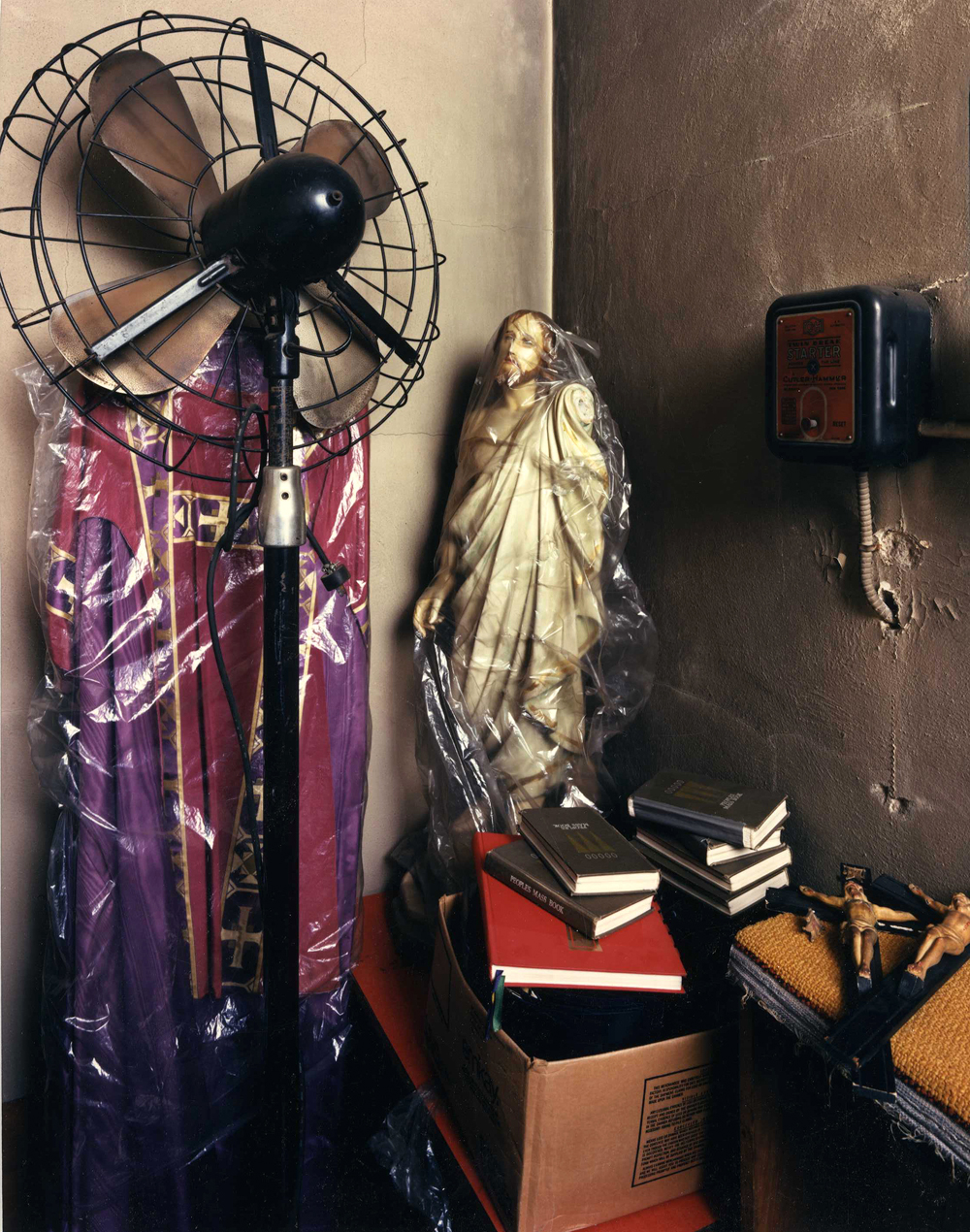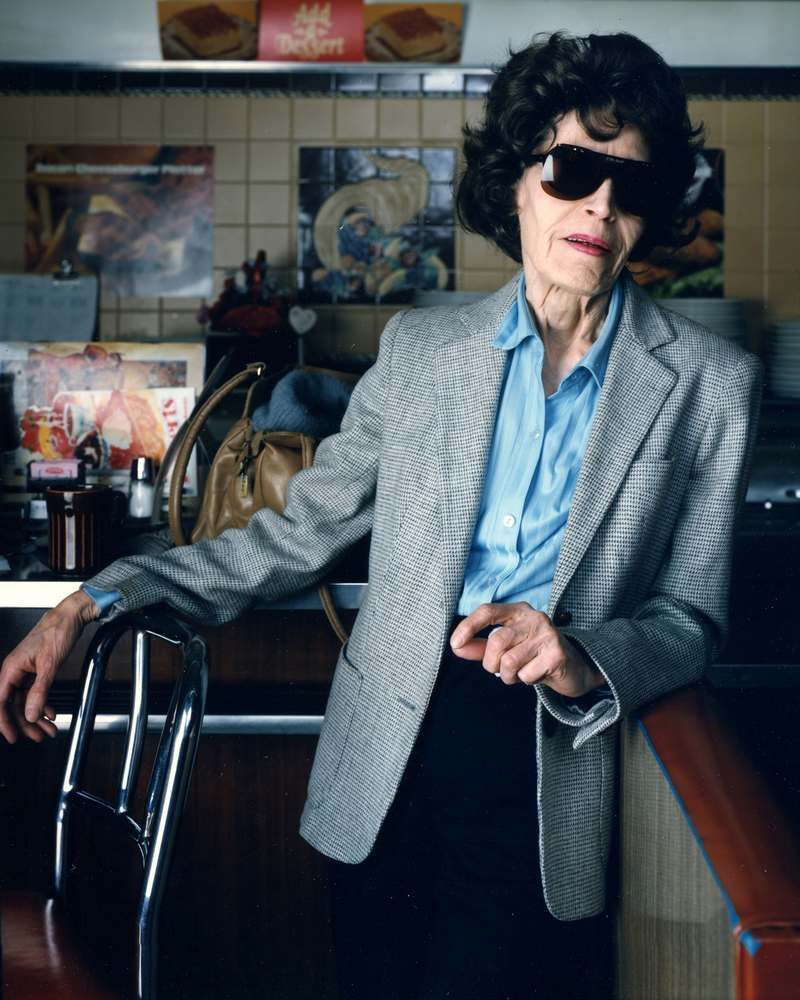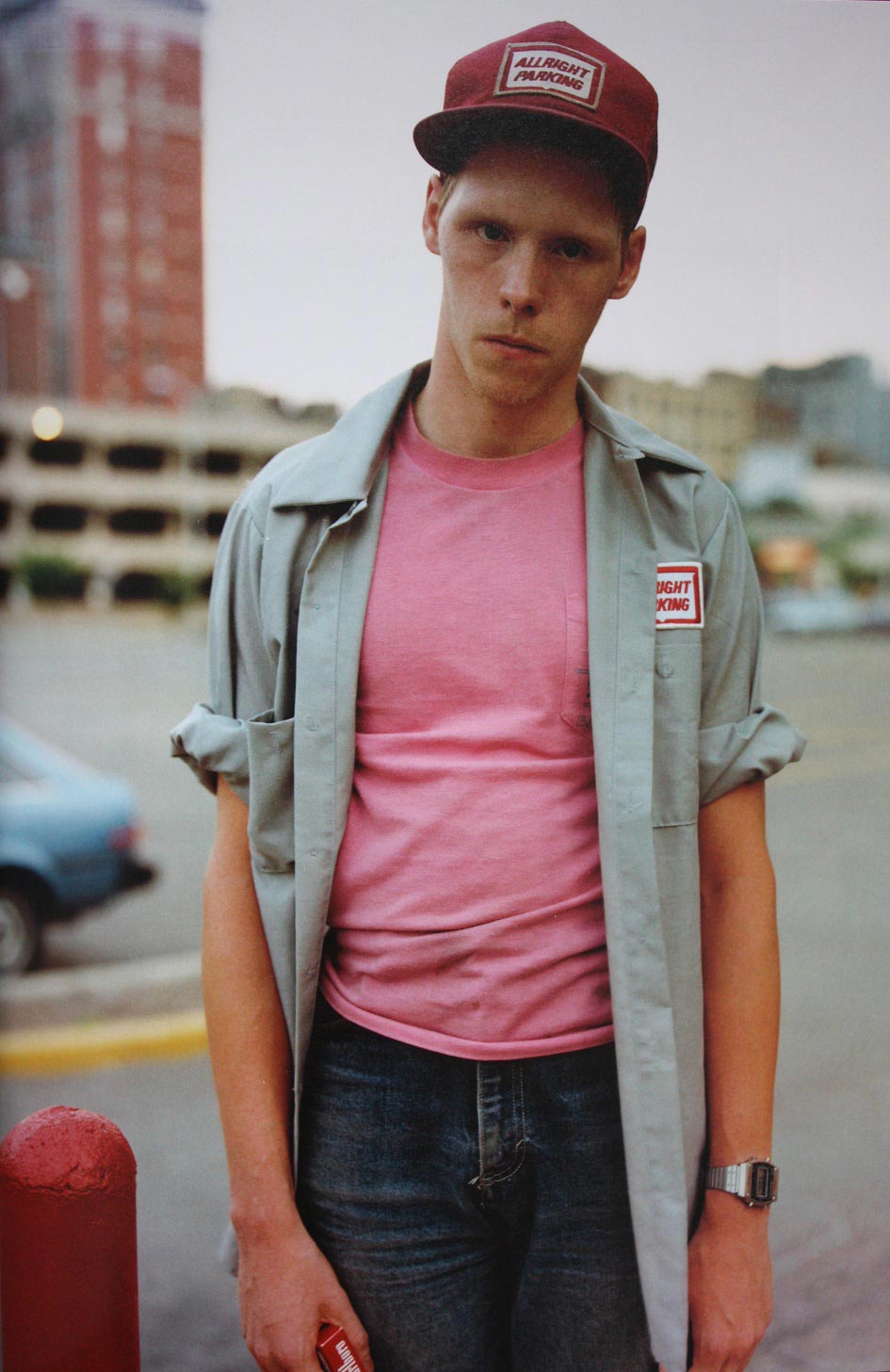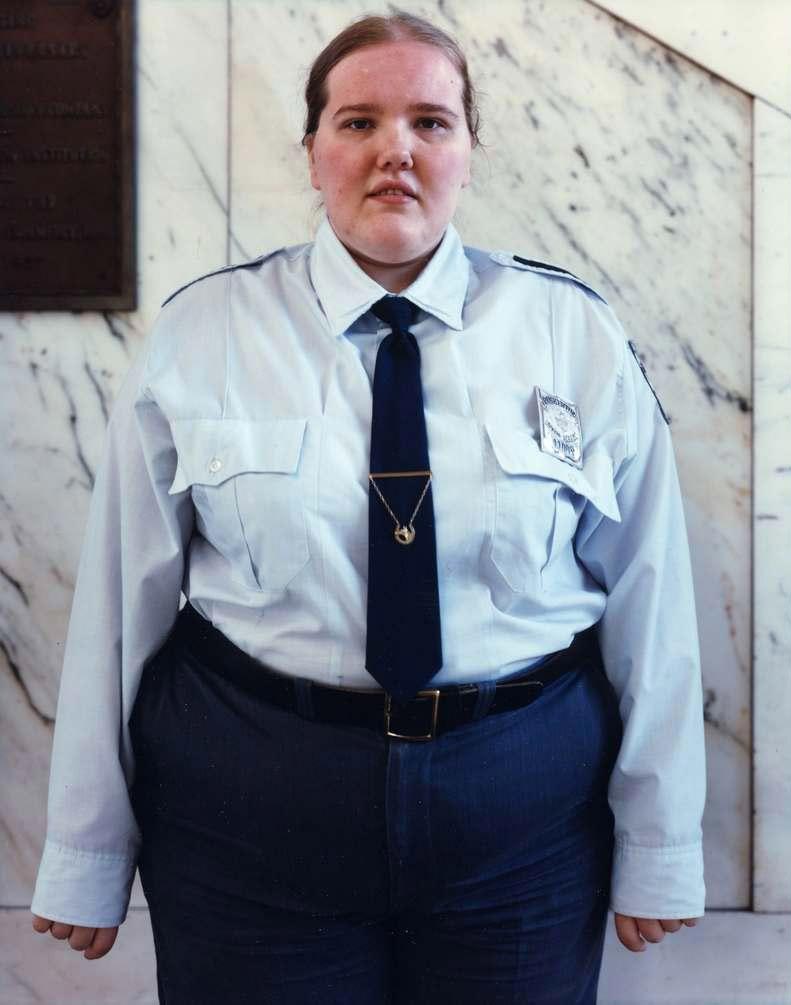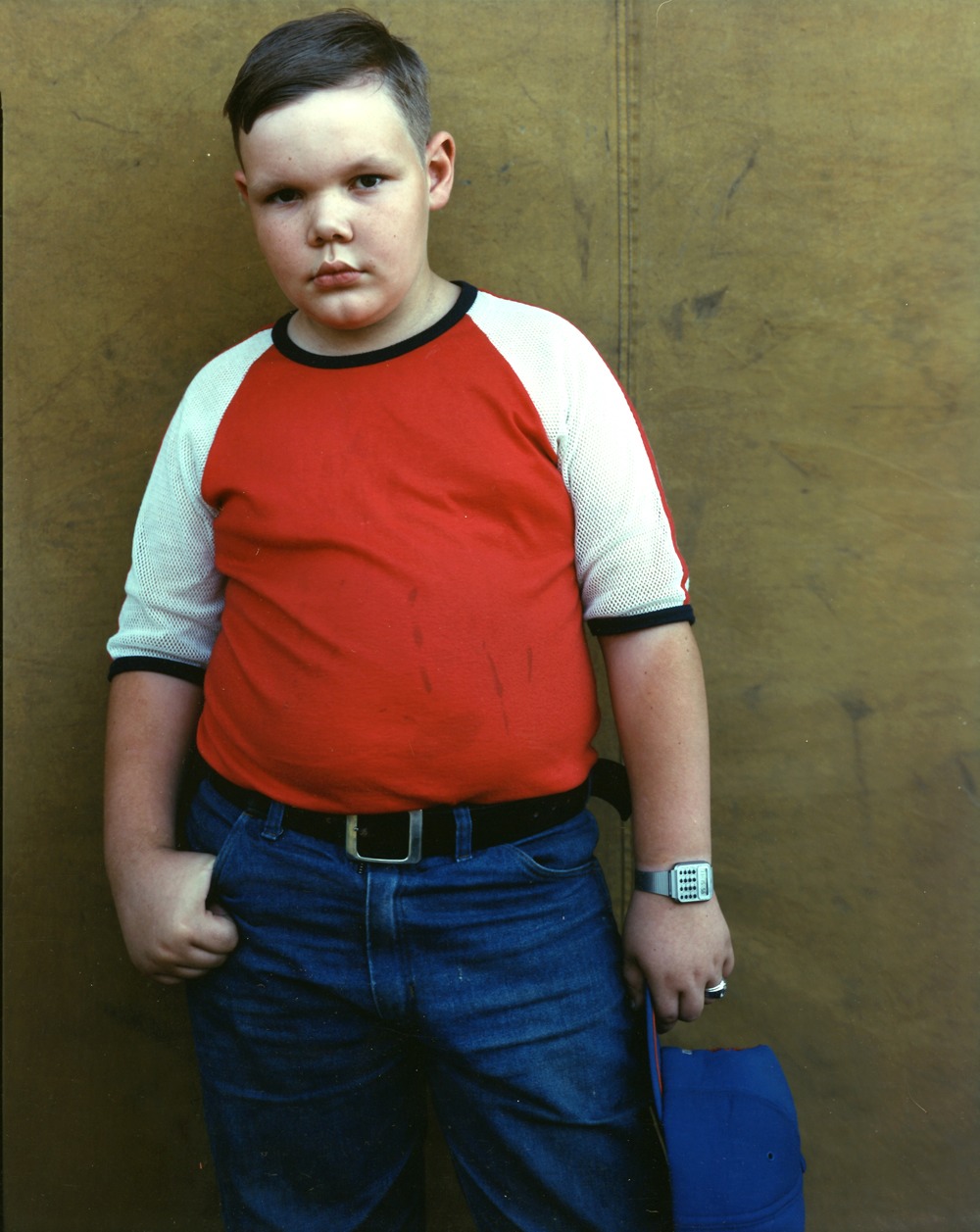“All I do know is that still photography will never be eclipsed by video, computer graphics, etc.”
An Interview with Bruce Wrighton
By Sean Phelan, Weekly Pennysaver, 1988
Mr. Wrighton began pursuing photography as his sole career when he came to the realization that “waiting tables was not going to be emotionally sustaining”. Though he dabbled with photography as a teenager and took some photography courses at the University of Rochester, it wasn’t until he moved to Binghamton in 1978 that the 38-year-old Finger Lakes region native began what, he calls,’seesawing between building up my commercial account base… and getting my personal work to a point where it seems able to live enough in myself to begin to push it out into the world”.
‘The Weekly’ spoke with Mr. Wrighton at his home on the westside of Binghamton where he lives with his wife Pat.
The Weekly: In the age-of videos, computer graphics productions – all these advanced image makers – where does the photographer with the single lens reflex camera fit in ?
Bruce Wrighton: When you say, ‘The photographer with the single lens reflex’, I suppose you mean – I’m not sure what you mean. Do you mean an amateur or do you mean a professional? A professional?
Single lens reflex is not an appropriate way in my mind to render a professional. I use an 8″ by 10″ camera exclusively for my own work. It is a substantially different way of operating. It is a far more meditative way. It is a far more cumbersome way. It’s a far more technically oriented way. It almost becomes a ritual to take a picture. And for some people they find that to be very important. I am one of those people. For other people the single lens reflex (SLR) bas great advantages. You can shoot quickly. It’s light, its portable, variety oflenses, etc. Those are not the things I find I need to draw the muse into me.
So let’s rephrase the question to say ‘Where does the still image fit in the age of videos, computer graphics, and even the computer altered image? They have these fantastic computers which put images together and there is a question of the veracity of images suddenly. Let’s backtrack.
When photography first came out there was an incredible psychological investment in it by people because of that veracity. In the 1840’s, 50’s and 60’s, people tended to look at photographs as being more truthful than their eyes. In fact, in some of the early daguerreotypes the resolution was quite good. They would look at these things through magnifying glasses and see things they couldn’t see with their eyes. There was a wonderful quality to daguerreotypes. Unfortunately you couldn’t work in that medium very long without getting mercury poisoning because of the process. All the same, I see that these computer things are going to throw even more into question the veracity of ‘images.’ It’s already happened. We all know that advertising images have been retouched. You look in a whiskey glass and see a nude woman or the devil’s face, whatever. It is just a step further in that direction.
As far as the video imaging quality-wise, there is no comparison. As far as the moving image versus the still image, there has been that comparison since the beginning of movies. I don’t think its any replacement. I think we are likely to just be shaken by the newness of some of this stuff without really having the experience of realizing that there is no real substitute for a still image. Again its like back when photography was invented, and while my memory is not the one to draw on, they said, ‘Painting is dead’. Photography could render things far more accurately than the painter’s brush and since up until that point the painter’s brush was in large part designed to render images in a life-like fashion, they thought the world was coming to end as far as painting (goes). In fact, what happened was impressionism, expressionism, and abstract art. It freed painting to explore other areas. I can’t foretell if anything like that is going to happen. All I do know is that still photography will never be eclipsed by video, computer graphics, etc.
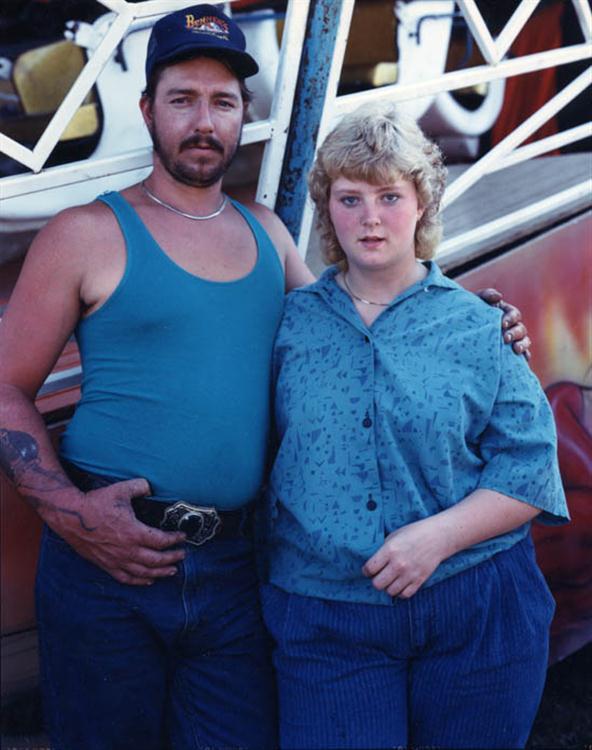
Couple in Blue, Owego Fair, 1987
“Lately I’ve been working much more with portraiture… street portraiture. Portraiture of those kinds of people who are, I don’t want to say are on the edge or fringe of society, but I want to give the sense that they are somehow alienated from the mainstream either by their own view of themselves or by society’s view of them.”
TW: In describing a series of photographs you took entitled: “St. George and the Dragon’, you have been quoted as saying that your intention was “the elevation of images to iconic symbols… (and how) these issues are played over the continua of sacred to secular, aesthetic to kitsch, and personal to universal,” What do those terms mean to the laymen trying to understand those photos?
BW: The pictures in that series are of a great divergence in what we would call ‘culture placement’. They were images of icons and statues in churches and religious settings. They were images, too, that came out of the allure of bars and those types of settings.
I essentially went into a lot of churches in the area and found icons or images that were by design a way to focus, a way to draw from a churchgoer a certain feeling or sense of devotion or a certain attitude. And I found a very similar feeling around town in barrooms, very old barrooms.
I was fascinated not by the similarity or the contrast between the two images, although quite candidly it was hard to tell which was the more powerful image as far as being allure for the muse. Some of the barrooms were exquisite and some of the churches were kitsch. I mean really bad as far as a general aesthetic appreciation.
What I was interested in was the underlying sense of what goes on when people use images in that way: how are images used to lure parts of unconscious into the conscious so we can then begin to work with them. I think that happens in both places and if you saw the pictures I would hope that you might sense that sometimes what’s going on in the secular places is far more sophisticated by its patina of time and just by the layering of human consciousness over these scenes. By the patina that gets laid down by the cultural psyche, rather than a well designed section of a church which is very clear or tries but misses at touching at that depository of collective unconscious.
In that series, I’m neither trying to give a bad name to churches and a good name to bars,or vice a versa. I’m more interested in pointing out a certain equilibrium that goes on and comes to a homeostasis as time and human consciousness is allowed to work its way over the tidiness of what some people would consider a beautifully clean design.
So most of the places I would photograph would be derelict. Derelict not in a pejorative way, but derelict in the sense that they had been neglected in time and there are several layers of dust.
An example would be that I found juice boxes standing side by side in the cellars of churches with icons of Christ. Prime images that stir the guts and hearts of humanity. As a corollary to that then is the sense that in this culture it is all too often easy to identify the sacred with some sort of non-corporeal status and the secular with some sort of gross embodiment. I tried to address that very much as a secondary issue by finding very ethereal bar scenes. Very beautiful in their own way. Like an old mural that bas a painting of some fisherman and some blue light coming in from the outside window and maybe a combination of a red table besides it… a sense of real charm and change that only an unconscious kind of coming together can provide. A real beauty that springs forth out of the human mind despite the fact that it is in what would be culturally considered sort of a gutsy, non-spiritual place.
I found some very spiritual, very ethereal scenes in these bars. And in the churches, remember I’m not saying that there weren’t the gutsy scenes in the bars and ‘the spiritual in the churches; but in some churches I found some horribly gruesome so-called sacred images that would only appeal to that gory instinct in humanity. That thing that leads us to watch all the T.V. programs about crime… not appealing in a spiritual sense of sacrifice or purging, or elevation, or refining the human spirit through suffering, but just the emotionally charged impact of gore and guts.
So I really tried in that series to not make that dicothomy between sacred and pure, secular and gross. That’s why I included that sense that within each category I hoped to demonstrate or illustrate the range that existed from that highly refined sense that again is an unconscious manifestation of a really unconscious, almost folk art and the really kitsch, the really clumsy, awkward attempt at consciously manipulating these forces that when they flow naturally can really express a beauty.
TW: What is your workday like in a “physical’ sense? What do you need to gather up and go out the door with?
BW: There are a bunch of physical things you need to do to prepare. You need to load the film, gather your equipment, load it in the car and go off, and whether you have a sense of where you’re going or not, depends on a number of factors.
I carry, as I’ve said, a large 8″ by 10″ camera. By 8″ by 10”, I mean the film size. The camera, of course, must be much larger to accomodate that. Heavy tripod. A big pack with film in it and light meters. An extra lens or two, so here I am lugging all this stuff around. If I’m working inside it tends to be very slow. The exposures are very long so if I’m working inside I’ll probably have to bring along some auxiliary lighting. This means carting around light stands, lights or strobe units. It gets to be very physically cumbersome.
Lately I’ve been working much more with portraiture… street portraiture. Portraiture of those kinds of people who are, I don’t want to say are on the edge or fringe of society, but I want to give the sense that they are somehow alienated from the mainstream either by their own view of themselves or by society’s view of them.
Summer’s a great time because I get to work with all the carnivals and fairs. A lot of the people who work those things are sort of in that category. They are the people for whom a nine-to-five job and a shirt and tie is an anathema to a sense of liberty or internal personal freedom that they feel they need to express themselves. They suffer because of that.
They suffer emotionally by being rejected in many cases and physically because they are not afforded economic opportunities in the same way that someone who can appear to fit or fits is allowed.
I think that it speaks to the immense power of the spirit and the incredible drive of the spirit to fulfill itself, to fulfill a commitment to the soul, that these people will put up with this in order to live out their particular calling. That can extend to perhaps the more obscure cases of the bums and drunks on the street to the rather more elavated cases of those people who at some point we recognize their individuality as genius. The Einsteins. The artists – the Matisses. Whoever gives up the mainstream, the comfortable capacity to be carried along with the rest of society, who relinquish that and replace it with sometimes a very frightening aloneness of seeking their own path.
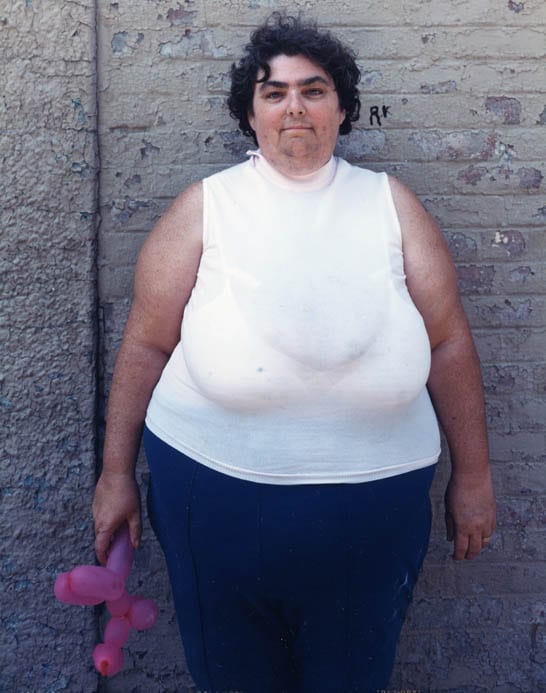
Woman with Balloon, Binghamton, NY, 1987
“Success is, of course, as an internal factor – a connection that we, or I, have made with whatever I am searching for. Sometimes it can be elusive. Sometimes it can be immediately self-evident.”
It can very frightening to realize that you have no support, that the answers must come from within. It’s not possible to take society’s standard answer and society’s standard comforts and just roll along in life: I think that some people choose that consciously and those are the people who, if we do respect people of this sort, are the ones we respect. And it can be done unconsciously and those are the people for whom life may seem more of a struggle, may seem more of a defiant act, may seem more as downtrodden because they’ve never accepted the fact that they are different and have to be different. There is a schism in them and at times it is a painful schism. There is a great desire to say, ‘Dam it, I really want to belong’, but they can’t. That spirit inside them says,’No’. And until they accept that it can be very painful seesaw.
So nowadays I have been working with those people, not the latter group who consciously accepted their lot, but the people for whom there is that struggle, for whom there is that tension between the spirit and the social norms. So I’go out to a carnival early before they start their rides up and talk to them and try to be open enough with them so that they trust me and I can try to make pictures. Quite often they fall into extremes. Either they are very open or very suspicious. For me it’s a personal challenge. I can’t tell you why I’m drawn to that now. It has been growing over the last year or two.
So I’ll go out to these places or it can be just be somebody downtown. Yesterday I saw a parking attendent who had just the right look in his eyes. I didn’t even introduce myself, I said,’Can I take your picture?’ And either because I was so forceful, or he was so open, or there was something in my sincerity, he just said, ‘Sure’.
He was a fairly young kid. Weeping eyes. Eyes that really spoke of the pain of having to struggle versus really wanting to find a home. As I chatted with him as I was making the picture – again setting up the 8 by 10 is not like the snap-snap of an SLR. It takes 16 minutes to get the whole thing together. It’s a comittment and it’s a building relationship.
I find that important because I need to develop some kind of rapport with these people. So during that rapport building session, he mentioned he was going in the army. I said to myself, ‘Gee that’s just so fitting’. To me when a young kid tells me they’re going in the army and they’re working in some parking lot or something like that; I don’t know for certain, but I say’This kid’s looking for direction’. But in his eyes I got the sense that the direction had to come from within him.
Anyway, the kid had a nice pink shirt and red hair and a red hat. There were aesthetic reasons as well (he laughs), the psychological and the spiritual element have to be there, but as well a successful image for me has to be aesthetically balanced.
TW: How does this complex mixture of concerns play themselves out in your photographs? What is distinctive about your work or style?
BW: If I was talking about it in “art historical’ terms or from the standpoint of the “art world”, I suppose it would be fairly traditional. Representational. Informational. Accessible as a representation of what was in front of the camera.
How does one come to that style? Why did I gravitate to that style? I don’t know. I think that to a large extent it is a combination of two factors.
One would be what I myself am comfortable with. What I myself relate to. The second thing is what the subject dictates. By subject I’m not necessarily meaning what is front of the camera, but what is trying to be described through that image.
This gets into a very interesting area – in my opinion – the image as a direct experience. The image as a primary experience. Meaning? We see and then we extrapolate information out of that. But there is an initial power in that image which is primary to the manipulation of that image, the interpretation of that image. That’s what I’m talking about when we come to an image which has a personal power or a cultural or universal power to it. I think we are talking about an image that can not be interpreted, that can not be defined, that cannot be pinned down. Why do we look at the Mona Lisa again, again and again? Why is the sun setting such a powerful image for us. And the image of that pops up thousands of times in postcards, in movies and on the western horizon outside your door. Yet there is an incredible power which lures us back over and over again to look at it.
Now trying to relate this back to style, we’re talking about trying to touch something of that power that is in the image before it becomes manipulated by consciousness. I think that’s the contribution that lends a particular power and appropriateness to a particular form of imaging a concept versus one which is limp or hollow.
TW: Is success then simply capturing that undisturbed image ? How do you measure success?
BW: Success is, of course, as an internal factor – a connection that we, or I, have made with whatever I am searching for. Sometimes it can be elusive. Sometimes it can be immediately self-evident. The expression. The pose. The posturing. There can be windows that open up that are surprises. But it’s that connection. It’s the connection between having a sense of what you are working for, but not really having it defined well enough, so you always have to search, you always have to dig a little bit, it’s always a little bit unknown what you are looking for.
If you know what you are looking for I’m not sure what the value of finding it is. That is to say, I’m not sure what’s the value of doing the search. At that point that part of you has been ‘played out’ so to speak. If I find myself making the same images over and over again, I begin to suspect that I have to dig a little harder or deeper to find what the next level of mystery is in a particular subject matter or go on to a different one.
It is in that act of searching or calling forth the muse that the magic and excitement and lure of taking the time to do this kind of thing derives.
In the two years prior to his death at age 38 in 1988, Bruce Wrighton photographed extensively near his home, using a cumbersome 8 x 10 inch tripod camera. He would ask the most ordinary of people, from a Woolworth shopper to a security guard, to pose for up to six minutes while he got everything in his viewfinder correct. Combining a strong sense of formal design with empathy for his subjects, he produced a singular body of work that is a unique document of a slice of America.
(Text @ Sean Phelan, Images @ Bruce Wrighton Estate courtesy of Laurence Miller Gallery)

